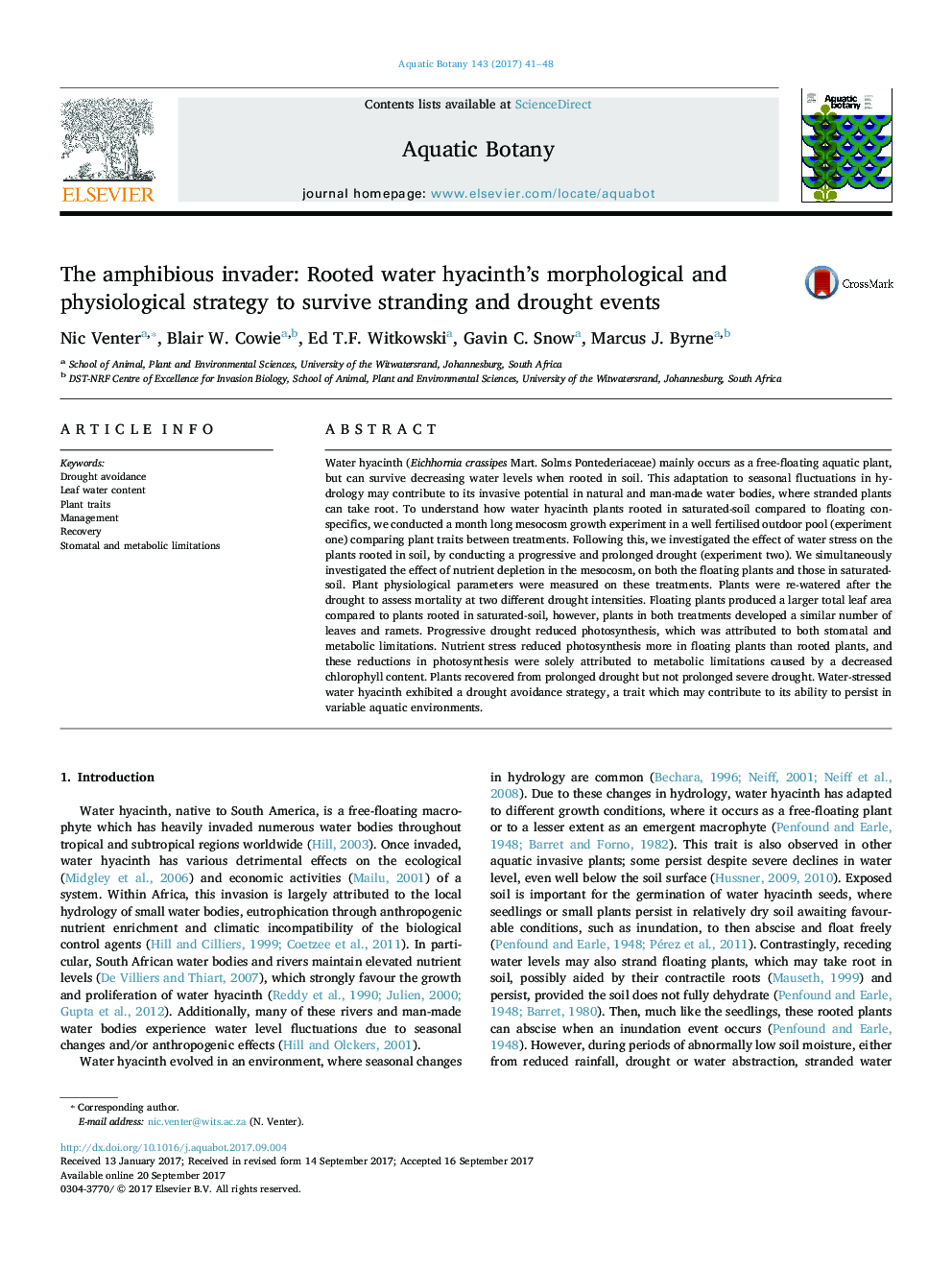| کد مقاله | کد نشریه | سال انتشار | مقاله انگلیسی | نسخه تمام متن |
|---|---|---|---|---|
| 5764028 | 1625799 | 2017 | 8 صفحه PDF | دانلود رایگان |
عنوان انگلیسی مقاله ISI
The amphibious invader: Rooted water hyacinth's morphological and physiological strategy to survive stranding and drought events
ترجمه فارسی عنوان
مهاجم مهاجم: استراتژی مورفولوژیکی و فیزیولوژیک سنبله آب ریشه ای برای زنده ماندن حوادث ریشه و خشکسالی
دانلود مقاله + سفارش ترجمه
دانلود مقاله ISI انگلیسی
رایگان برای ایرانیان
کلمات کلیدی
اجتناب از خشکسالی، محتوای آب برگ صفات گیاهی، مدیریت، بهبود، محدودیت های دندانی و متابولیکی،
موضوعات مرتبط
علوم زیستی و بیوفناوری
علوم کشاورزی و بیولوژیک
علوم آبزیان
چکیده انگلیسی
Water hyacinth (Eichhornia crassipes Mart. Solms Pontederiaceae) mainly occurs as a free-floating aquatic plant, but can survive decreasing water levels when rooted in soil. This adaptation to seasonal fluctuations in hydrology may contribute to its invasive potential in natural and man-made water bodies, where stranded plants can take root. To understand how water hyacinth plants rooted in saturated-soil compared to floating conspecifics, we conducted a month long mesocosm growth experiment in a well fertilised outdoor pool (experiment one) comparing plant traits between treatments. Following this, we investigated the effect of water stress on the plants rooted in soil, by conducting a progressive and prolonged drought (experiment two). We simultaneously investigated the effect of nutrient depletion in the mesocosm, on both the floating plants and those in saturated-soil. Plant physiological parameters were measured on these treatments. Plants were re-watered after the drought to assess mortality at two different drought intensities. Floating plants produced a larger total leaf area compared to plants rooted in saturated-soil, however, plants in both treatments developed a similar number of leaves and ramets. Progressive drought reduced photosynthesis, which was attributed to both stomatal and metabolic limitations. Nutrient stress reduced photosynthesis more in floating plants than rooted plants, and these reductions in photosynthesis were solely attributed to metabolic limitations caused by a decreased chlorophyll content. Plants recovered from prolonged drought but not prolonged severe drought. Water-stressed water hyacinth exhibited a drought avoidance strategy, a trait which may contribute to its ability to persist in variable aquatic environments.
ناشر
Database: Elsevier - ScienceDirect (ساینس دایرکت)
Journal: Aquatic Botany - Volume 143, October 2017, Pages 41-48
Journal: Aquatic Botany - Volume 143, October 2017, Pages 41-48
نویسندگان
Nic Venter, Blair W. Cowie, Ed T.F. Witkowski, Gavin C. Snow, Marcus J. Byrne,
